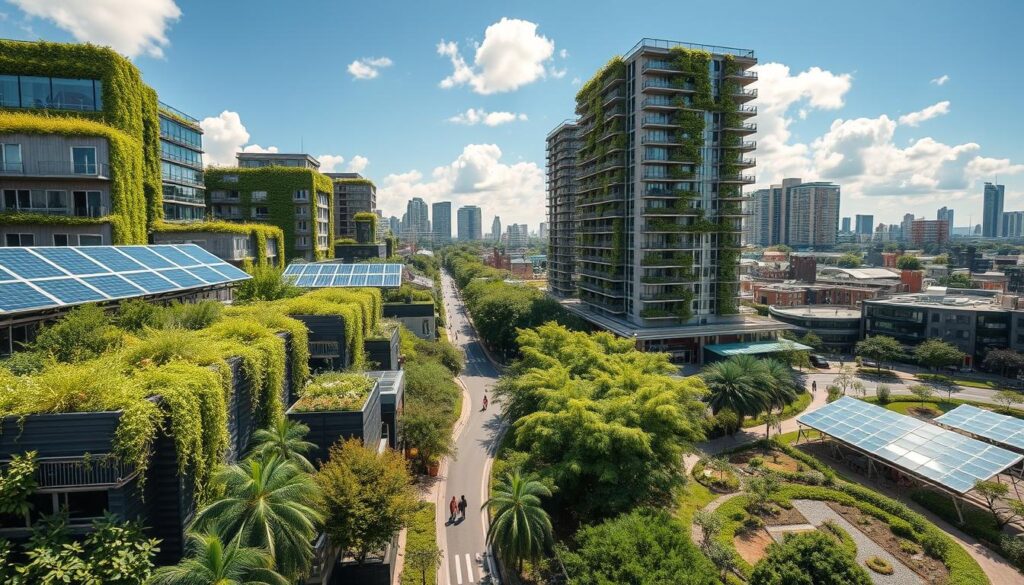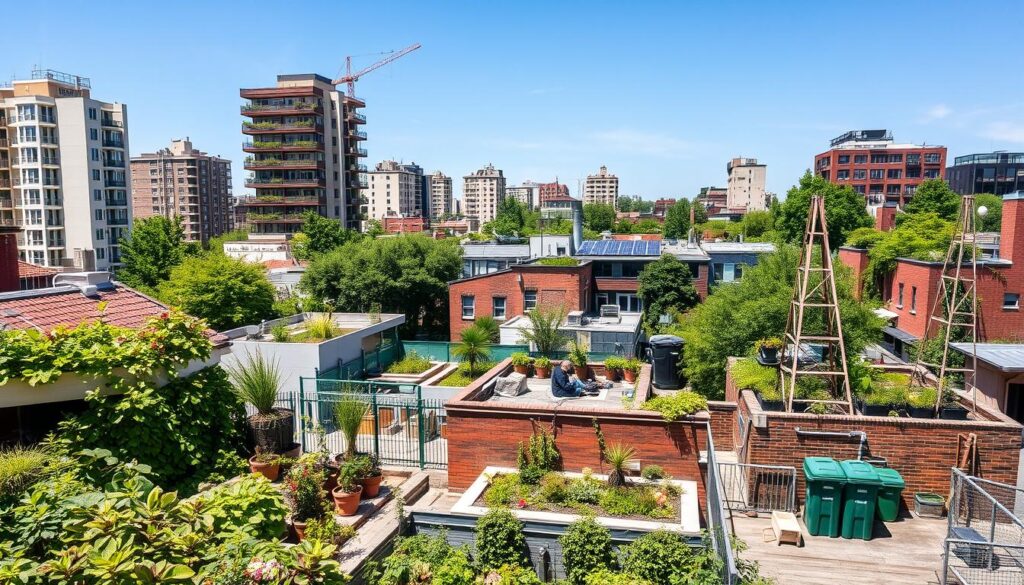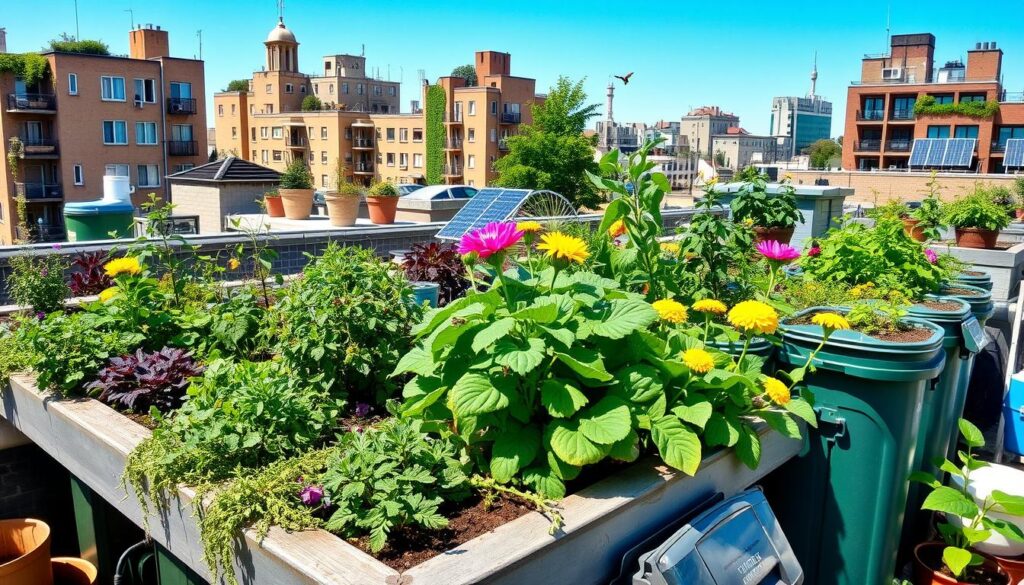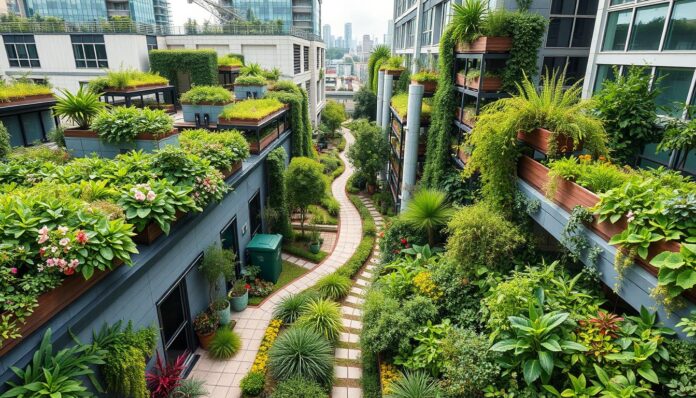Permaculture urban systems bring new ideas to solve urban problems. They aim to make cities sustainable, like nature. This design is for closed loop, zero waste systems, not just for gardens but for cities too.
By using permaculture, cities can become greener and stronger. This is key for planning cities that are good for the planet.
Sepp Holzer’s visit to Southeast Michigan shows more people want permaculture in cities. Bill Mollison and David Holmgren started permaculture in 1978. Now, it’s vital for designing cities.
By 2050, cities will be home to 68% of the world’s people. This makes permaculture solutions even more urgent.
Urban permaculture can cut down on run-off by 50%. This keeps soil moist. It also makes cities more diverse, with 25% more native species than regular gardens.
A good urban permaculture plan can also cut down landfill waste by 30%. This is a big step towards a greener city.
Key Takeaways
- Permaculture urban systems offer innovative solutions to urban sustainability challenges.
- Urban permaculture design aims to create closed loop, zero waste systems.
- Implementing urban permaculture solutions can reduce urban run-off by up to 50%.
- Urban zones can increase biodiversity by providing habitat for 25% more native species.
- A well-designed urban permaculture system can divert about 30% of urban waste from landfills.
- Permaculture urban systems are essential for sustainable city planning and urban permaculture design.
Introduction to Permaculture in Urban Systems
Permaculture is a design system that aims to create sustainable environments. It’s used in cities to make spaces like gardens and green roofs. This method helps improve life for city people by focusing on eco-friendly urban development and urban gardening solutions.
Some key benefits of permaculture in cities include:
- Enhanced food security through local food production
- Increased biodiversity in urban areas
- Improved air and water quality
- Creation of community spaces and social connections
By using permaculture in urban planning, cities can become more sustainable. This is done through urban gardening solutions like rooftop gardens and community spaces. Cities can then reduce their environmental impact and improve resident well-being, supporting eco-friendly urban development.
A study showed that community gardens can fight food deserts by offering fresh produce. This shows permaculture’s role in solving urban food security issues and supporting sustainable eco-friendly urban development.
| Benefits of Permaculture | Urban Application |
|---|---|
| Food Security | Community Gardens, Rooftop Gardens |
| Biodiversity | Green Spaces, Urban Forestry |
| Community Engagement | Community Gardens, Urban Agriculture Workshops |
Benefits of Implementing Permaculture
Permaculture in urban areas brings many benefits. It helps create sustainable food sources and boosts biodiversity. By using green infrastructure in cities, we can lessen our need for industrial farming. This supports more eco-friendly urban planning. It also helps provide fresh, local food to city folks.
The perks of permaculture are many. Some key benefits include:
- Enhanced food security through local food production
- Increased biodiversity in urban ecosystems
- Community engagement and education on sustainable practices
By embracing permaculture, cities can become more resilient and green. This is crucial since over 55% of the world’s population lives in cities. These areas produce a lot of carbon dioxide. 
Sustainable Food Sources
Permaculture makes urban areas more sustainable by offering fresh, local food. This cuts down on the carbon footprint from food transport. It encourages more eco-friendly food systems.
Biodiversity Enhancement
Permaculture boosts biodiversity in cities by creating homes for pollinators and wildlife. This is vital since lawns take up a lot of urban green space. It shows a chance to increase biodiversity.
Community Engagement
Getting the community involved is key in permaculture. By letting local people help plan and do permaculture projects, we teach them about green living. It builds a sense of community.
Key Principles of Urban Permaculture
Urban permaculture focuses on making cities sustainable and regenerative. It starts with observing and interacting with the environment. This helps designers create systems that fit the local area perfectly.
Energy efficiency is another key principle. Urban permaculture aims to cut down waste and boost productivity. It uses methods like rainwater tanks, composting, and mulching to save resources.
The idea of integrating rather than segregating is vital. It means combining plants, animals, and community activities. This approach makes urban ecosystems more resilient and sustainable, supporting food production and urban resilience.
Urban permaculture’s main principles are:
* Observing and interacting with the environment
* Energy efficiency
* Integrating rather than segregating
* Using small and slow solutions
* Producing no waste
These principles help create sustainable urban systems. They work in small gardens and large urban farms alike.
| Principle | Description |
|---|---|
| Observing and interacting | Understanding the local context and needs to create tailored systems |
| Energy efficiency | Reducing waste and enhancing productivity through energy-efficient methods |
| Integrating rather than segregating | Combining different elements to maximize productivity and efficiency |
Design Strategies for Urban Permaculture
More than half of the world’s population lives in cities now. This makes sustainable city planning and permaculture urban systems crucial. Permaculture design helps make cities productive and sustainable by using space and resources wisely.
Zone planning is a key part of permaculture design. It divides urban areas into zones based on how they are used and how easy they are to get to. This method cuts down on energy use and boosts efficiency in urban permaculture systems. Sector analysis is also vital. It looks at how climate, wind, and sunlight affect the city.
Managing water well is essential in urban permaculture. Techniques like rainwater harvesting and greywater systems help save water and make cities more resilient. These strategies make cities better places to live, offering a high quality of life.

| Design Strategy | Description | Benefits |
|---|---|---|
| Zone Planning | Dividing urban space into different zones based on usage and accessibility | Reduced energy consumption, increased efficiency |
| Sector Analysis | Analyzing external factors that affect the urban environment | Improved understanding of urban ecosystem, enhanced design |
| Water Management | Techniques such as rainwater harvesting and greywater systems | Reduced water waste, enhanced urban resilience |
By using these design strategies in urban planning, cities can become more sustainable and resilient. This is key for creating thriving and regenerative urban ecosystems. It’s all about making cities better places to live.
Selecting the Right Plants
Choosing the right plants is key for a successful urban garden. You need to think about the climate, soil, and space you have. Native plants are often a smart pick because they fit well with the local environment and need less care.
Non-native plants can work too, but pick ones that match your local climate and soil. Companion planting is also important. It means picking plants that help each other grow and fight pests.
Native vs. Non-Native Plants
Native plants usually do better in urban gardens. They need less care and thrive in the local climate. But, non-native plants can add variety and interest to your garden.
Companion Planting Principles
Companion planting is a big part of urban gardening. It helps create a balanced garden ecosystem. For instance, marigolds can keep nematodes away from tomatoes, and basil can make lettuce taste better.
Vertical Gardening Solutions
Vertical gardens are perfect for small spaces in cities. They use trellises, arbors, or wall planters to save space. Good plants for vertical gardens include succulents, herbs, and climbing vines.
- Check if the plants fit your climate and soil.
- Think about how much space you have and how plants grow.
- Look for plants that resist pests and diseases.
- Consider how plants can help each other grow.
By picking the right plants and using smart gardening methods, you can build a green oasis in the city.
Soil Health and Management
Soil health is key in sustainable urban agriculture. It affects how well food is produced in cities. Healthy soil helps plants grow, filters water, and stores carbon.
In urban permaculture, testing and improving soil is important. This means checking the soil’s pH, nutrients, and structure. Composting helps make soil better by recycling organic materials and cutting down waste.

Mulching is also crucial for soil health. It keeps moisture in, stops weeds, and controls soil temperature. These practices help cities grow food sustainably and lessen their environmental impact. Some important strategies include:
- Soil testing and analysis to inform amendment decisions
- Composting and organic matter incorporation to enhance soil fertility
- Mulching and cover cropping to reduce erosion and retain moisture
By using these methods, cities can make their food systems better. This leads to a healthier and more sustainable environment.
Water Conservation Techniques
Water conservation is key for sustainable urban permaculture systems. Using green infrastructure like rainwater harvesting and greywater systems helps. These methods cut down on water waste and boost urban water security.
Effective water-saving techniques include:
- Rainwater harvesting: collecting and storing rainwater for irrigation and other non-potable uses
- Greywater systems: reusing water from sinks, showers, and washing machines for irrigation and flushing toilets
- Permeable surfaces: using materials like permeable pavers, gravel, or mulch to reduce stormwater runoff and recharge groundwater
By using these methods, cities can use less water and rely less on municipal supplies. For instance, rainwater harvesting can provide a steady water source for irrigation, reducing tap or well water use. Organic mulch also lowers irrigation needs by reducing evaporation.
Also, using drought-tolerant plants and swales and berms improves water retention and groundwater recharge. These techniques help cities become more resilient through permaculture and support sustainable development.
Space Optimization in Urban Environments
Urban populations are set to double by 2050. It’s crucial to make urban spaces more sustainable and productive. Urban gardening solutions can boost food production and biodiversity. For instance, permaculture design helps create efficient urban gardens.
Here are some ways to make the most of urban space:
- Container gardening lets you grow many plants in small areas.
- Rooftop gardens add more space for gardening and cool down cities.
- Using parks and community gardens for gardening brings people together.
These sustainable urban agriculture methods help cities use less fossil fuel and waste. They also give fresh food to city folks. Permaculture practice shows how local food production cuts down on emissions from transport.
By using these strategies, cities can build better food systems. This makes them more sustainable and resilient. It’s a step towards a greener urban future.
| Strategy | Benefits |
|---|---|
| Container Gardening | Space-efficient, increased crop yields |
| Rooftop Gardens | Reduced urban heat island effects, increased biodiversity |
| Using Public Spaces | Fostered community involvement, increased food access |
Community Involvement in Urban Permaculture
Urban permaculture systems need community help to thrive. Workshops and education teach people about growing food in cities. This knowledge helps local food co-ops share fresh, local produce.
Volunteering is key for community bonding. Helping in community gardens builds social skills and relationships. It’s vital for making cities sustainable as more people move to cities.
Projects like Beacon Food Forest in Seattle and Melbourne’s urban farms show success. They cut costs, use less energy, and support green living. These efforts highlight urban permaculture’s power.
Benefits of Community Involvement
- Develops social skills and builds relationships
- Contributes to the development of green infrastructure in cities
- Promotes sustainable living practices and reduces economic costs
- Enhances community engagement and social cohesion
Community involvement in urban permaculture makes cities better. As cities grow, focusing on food and green spaces is crucial. It ensures a healthy future for everyone.
Technology Integration in Permaculture Design
Exploring urban resilience through permaculture shows technology’s key role. It boosts the efficiency and output of urban permaculture. Smart irrigation systems and apps help manage gardens better. This leads to less water waste and more sustainable urban agriculture.
Technology in permaculture design offers many benefits:
- Smart irrigation saves water
- Data-driven garden management boosts crops and cuts waste
- Digital platforms engage and educate communities
By using technology and sustainable urban agriculture, we make urban areas better. This helps us build a greener, more sustainable future.
Policy and Permaculture
Permaculture urban systems are key to making cities sustainable. Policy greatly affects how these systems grow. Zoning laws can either help or block the creation of urban gardens and green spaces.
Incentives for urban farming can bring people together. For instance, California’s Urban Agriculture Incentive Zones Act lets landowners farm in exchange for tax breaks. Cities also give grants and support to groups starting gardens in homes.
Some cities have special zoning for urban farming. These rules help mix farming into city planning. This supports sustainable city planning and permaculture urban systems. Here are some policies that help:
- Urban agriculture zoning codes
- Incentives for urban agriculture
- Grants and support for community gardens
By using these policies, cities can boost permaculture urban systems and sustainable planning. This makes cities better places to live and more sustainable.
| City | Policy | Impact |
|---|---|---|
| California | Urban Agriculture Incentive Zones Act | Increased urban agriculture and community engagement |
| Chicago | Urban agriculture zoning code | Integrated agriculture into urban planning |
Challenges of Urban Permaculture
Urban permaculture systems face unique challenges. These include limited space, soil contamination, and climate considerations. To tackle these, urban gardening solutions are essential. They require careful planning and design.
Using container gardens and rooftop gardens can make the most of available space. Choosing plants that thrive in different climates helps combat climate change.
Soil contamination is a big problem in urban permaculture. It can harm plant growth and human health. To fix this, green infrastructure in cities can include soil remediation. This uses plants to clean pollutants from the soil.
Some of the challenges of urban permaculture include:
- Space limitations: Limited space in urban areas can make it difficult to implement permaculture designs.
- Soil contamination: Contaminated soil can be a significant challenge in urban permaculture.
- Climate considerations: Urban permaculture systems must be designed to withstand the urban heat island effect and other climate-related challenges.
Despite these challenges, urban permaculture offers many benefits. It can increase food security, improve air quality, and foster community engagement. By using urban gardening solutions and green infrastructure in cities, we can make urban environments more sustainable and resilient.
| Challenge | Solution |
|---|---|
| Space limitations | Container gardens, rooftop gardens |
| Soil contamination | Soil remediation techniques, phytoremediation |
| Climate considerations | Climate-resilient plants, green infrastructure |
Case Studies of Successful Urban Permaculture
Urban permaculture has been a hit in many cities. It shows how to make sustainable urban agriculture systems work. For example, New York City’s green roofs do more than just look good. They keep buildings warm, cut down on water runoff, and help animals find homes.
In Seattle, urban farms are a big deal. They help make food more secure and bring people together. These farms give fresh food to locals and teach them about growing food the right way.
Los Angeles has community gardens that are doing great things. These gardens help people connect and feel part of a community. They also give people access to healthy, fresh food.
| City | Project | Benefits |
|---|---|---|
| New York City | Green Roofs | Insulation, reduced stormwater runoff, wildlife habitats |
| Seattle | Urban Farms | Food security, community engagement, education |
| Los Angeles | Community Gardens | Social cohesion, access to fresh produce, community building |
Future of Permaculture in Urban Areas
As cities grow, with over 68% of people expected to live in them by 2050, we need sustainable food systems. Permaculture in cities can help by reducing our reliance on industrial food, which is bad for the environment. It also makes food more secure and supports local production through smart city planning.
Urban agriculture is evolving, with vertical gardening solutions and community gardens leading the way. These can boost local food by up to 40%. Community gardens also improve mental health and bring people together, showing the power of permaculture in cities.
For more on urban permaculture, check out permaculturepractice.com. It’s full of the latest on sustainable city planning and permaculture systems.
The future of permaculture in cities is bright. With the right policies, like better zoning laws, we can grow more green spaces. As cities expand, the role of permaculture and sustainable planning will grow, leading to better, greener cities.
| Benefits of Urban Permaculture | Percentage Increase |
|---|---|
| Local Food Production | 40% |
| Per Capita Vegetable Consumption | 24% |
| Social Cohesion | 50% |
Conclusion: Embracing Permaculture for Sustainable Cities
Permaculture is a way to make cities better. It helps cities become sustainable, productive, and strong. By using urban food production and green spaces, cities can improve food security and biodiversity.
Permaculture teaches us to be efficient and not waste anything. It encourages us to work together and use every resource. This can turn our cities into green spaces, from gardens on rooftops to edible streets.
As more people move to cities, we need green solutions now more than ever. By using permaculture, we can build cities that are good for people and the planet. Let’s start making our cities greener and stronger with permaculture.

